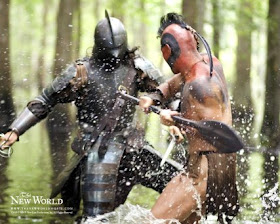 I must make a confession. I've watched the movie The New World twice. On the first occasion, I had no preconceptions. Except for the usual Pocahontas myth, I knew little about the history, and I loved the Virginia scenery. Drawn to the accuracy of recreating Jamestown, I was impressed that the movie also didn't seem to dismiss the Powhatan as "Savages." Although extremely slow moving, I enjoyed it.
I must make a confession. I've watched the movie The New World twice. On the first occasion, I had no preconceptions. Except for the usual Pocahontas myth, I knew little about the history, and I loved the Virginia scenery. Drawn to the accuracy of recreating Jamestown, I was impressed that the movie also didn't seem to dismiss the Powhatan as "Savages." Although extremely slow moving, I enjoyed it.So why would I sit through watching an overly long movie a second time? Simple. Since my first viewing, I've extensively researched the era. Forearmed with some knowledge of the actual history as well as having learned more about the Powhatan, I wanted to see what I had missed in the first viewing.
The story of The New World begins with English colonists landing at Jamestown, Virginia, in 1607. It focuses on the love story of John Smith and Pocahontas. Because this story has been repeated so many times in history classes and through a Disney cartoon (one that I have not seen), most people are familiar with some aspects. As I mentioned earlier, the myth is perpetuated yet again in this film. Pocahontas was around eleven years old when the colonists first came to Jamestown, so unless people are willing to admit that Smith was a pedophile, there was no love story. Oops, there goes the plot!
Pocahontas is also portrayed saving Smith's life. This is a much disputed point among scholars, which I'll save for a future blog as it's a topic in itself. The movie continues on at a rambling pace and shows the Starving Time, which occurred in Jamestown during the winter of 1609-10. In reality, Smith had returned to England in the fall of 1609, never to return to Virginia.
Later, viewers see Smith punished for opposing the abduction of Pocahontas. Mind you, the real Smith was in England, and Pocahontas, by this time, had married a Powhatan warrior by the name of Kokum. Smith did claim in his writings that he had been against the abduction, but it was from a distance and long after the fact.
After the abduction, Smith leaves for New England, having other colonists tell Pocahontas that he has died. Again in reality, Smith did sail for New England, but he sailed from England, not Virginia. In the movie, Pocahontas grieves until she is saved by the love of John Rolfe. The plot closely resembles a poorly written romance novel.
After Pocahontas marries Rolfe, she's thrilled at dressing and behaving like the English. Eventually, she has a son, and the happy family sails for England, where she's entertained by royalty. Nothing is said about how she was on exhibition to show that the Indians could indeed be "civilized." And when she meets Smith again, which actually took place, the producers didn't see fit to show how angry she was with him. The colonists had told her that he had died when he left Virginia, and several hours passed before she composed herself enough to speak with him. The real confrontation was glossed over for a fairytale meeting, so that she realized Rolfe was her true love, and they could live happily ever after. The truth is she died, and shortly after, Rolfe abandoned their son in England.
Was the movie all bad? No. The Virginia scenery was lavish and breathtaking. The attention to details in the rebuilding of the Jamestown fort was fantastic. Even the Powhatan town was great. However, there was no depth to the Powhatan themselves. The men's hairstyles were correct, as well as the fact that the men painted themselves when they went into battle or performed rituals. But they were shown painted in most of the scenes as if they never took it off. Heaven forbid, showing the women attired correctly was out of the question. Someone might be offended by a bare breast.
 The battle scenes seemed staged, which of course, they were, and they never truly showed off the Powhatan warriors' abilities with their bows. Contrary to what most believe, Powhatan archers held superior weapons to the colonists' matchlock rifles. I was also bothered by the unrealistic, jerky arm movements of the Powhatan, which more resembled chimpanzee motions than anything human.
The battle scenes seemed staged, which of course, they were, and they never truly showed off the Powhatan warriors' abilities with their bows. Contrary to what most believe, Powhatan archers held superior weapons to the colonists' matchlock rifles. I was also bothered by the unrealistic, jerky arm movements of the Powhatan, which more resembled chimpanzee motions than anything human.All in all, The New World perpetuates the Native American myths and stereotypes, not only in retelling the story of Pocahontas, but the fact that they needed to be "civilized." The beautiful scenery was land free for the taking. Why else would the movie have been called The New World when for the many inhabitants already living in the Americas it was anything but new? My heart goes out to the descendants, wondering if they will ever be allowed to tell their side to the story.
Kim Murphy
www.KimMurphy.Net